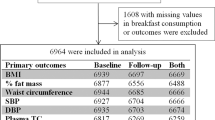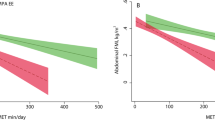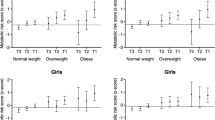Abstract
Objectives:
The aim of this study was to assess associations between habitual school-day breakfast consumption, body mass index (BMI), physical activity (PA) and cardiorespiratory fitness (CRF).
Methods:
BMI, PA and CRF were measured in 4326 schoolchildren aged 10–16 years. Participants were classified as obese or non-obese, as having low or high PA and CRF. Habitual school-day breakfast consumption was assessed by a questionnaire and classified as never, sometimes or always.
Results:
Participants who sometimes ate breakfast were more likely to be obese than those who always did (P<0.05). Boys who never ate breakfast were more likely to have low PA odds ratio (OR) 2.17, 95% CI 1.48–3.18) and low CRF (OR 2.02, 95% CI 1.40–2.93) than those who always did. Compared with those who always did so, girls were more likely to have low PA if they sometimes (OR 1.39, 95% CI 1.13–1.70) or never (1.48 95% CI 1.06–2.05) ate breakfast, but the likelihood of low CRF was not different between groups.
Conclusions:
Habitual breakfast consumption is associated with healthy BMI and higher PA levels in schoolchildren. In boys, regularly eating breakfast is also associated with higher levels of CRF. The higher PA observed in habitual breakfast eaters may explain the higher CRF values observed. These positive health behaviours and outcomes support the encouragement of regular breakfast eating in this age group.
This is a preview of subscription content, access via your institution
Access options
Subscribe to this journal
Receive 12 print issues and online access
$259.00 per year
only $21.58 per issue
Buy this article
- Purchase on Springer Link
- Instant access to full article PDF
Prices may be subject to local taxes which are calculated during checkout
Similar content being viewed by others
References
Aarnio M, Winter T, Kujala U, Kaprio J (2002). Associations of health related behaviour, social relationships, and health status with persistent physical activity and inactivity: a study of Finnish adolescent twins. Br J Sports Med 36, 360–364.
Albertson AM, Thompson D, Franko DL, Kleinman RE, Barton BA, Crockett SJ (2008). Consumption of breakfast cereal is associated with positive health outcomes: evidence from the National Heart, Lung, and Blood Institute Growth and Health Study. Nutr Res 28, 744–752.
Berkey CS, Rockett HR, Gillman MW, Field AE, Colditz GA (2003). Longitudinal study of skipping breakfast and weight change in adolescents. Int J Obes Relat Metab Disord 27, 1258–1266.
Blair SN, Cheng Y, Holder JS (2001). Is physical activity or physical fitness more important in defining health benefits? Med Sci Sports Exerc 33 (6 Suppl), S379–S399; discussion S419-320.
Blair SN, Kohl HW III, Paffenbarger RS Jr, Clark DG, Cooper KH, Gibbons LW (1989). Physical fitness and all-cause mortality. A prospective study of healthy men and women. JAMA 262, 2395–2401.
Boreham C, Robson PJ, Gallagher AM, Cran GW, Savage JM, Murray LJ (2004). Tracking of physical activity, fitness, body composition and diet from adolescence to young adulthood: the Young Hearts Project, Northern Ireland. Int J Behav Nutr Phys Act 1, 14.
Cohen B, Evers S, Manske S, Bercovitz K, Edward HG (2003). Smoking, physical activity and breakfast consumption among secondary school students in a southwestern Ontario community. Can J Public Health 94, 41–44.
Cole TJ, Bellizzi MC, Flegal KM, Dietz WH (2000). Establishing a standard definition for child overweight and obesity worldwide: international survey. BMJ 320, 1–6.
Cole TJ, Freeman JV, Preece MA (1995). Body mass index reference curves for the UK, 1990. Arch Dis Child 73, 25–29.
Croezen S, Visscher TL, Ter Bogt NC, Veling ML, Haveman-Nies A (2009). Skipping breakfast, alcohol consumption and physical inactivity as risk factors for overweight and obesity in adolescents: results of the E-MOVO project. Eur J Clin Nutr 63, 405–412.
Cureton KJ, Plowman SA (2005). FITNESSGRAM Reference Guide. Cooper Institute: TX.
Cureton KJ, Plowman SA (2007). Aerobic Capacity Assessments. Fitnessgram/Activitygram Reference Guide. MD Meredith and GJ Welk, Human Kinetics/The Cooper Institue: Dallas.
Dencker M, Thorsson O, Karlsson MK, Linden C, Svensson J, Wollmer P et al. (2006). Daily physical activity and its relation to aerobic fitness in children aged 8–11 years. Eur J Appl Physiol 96, 587–592.
Dubois L, Girard M, Potvin Kent M, Farmer A, Tatone-Tokuda F (2009). Breakfast skipping is associated with differences in meal patterns, macronutrient intakes and overweight among pre-school children. Public Health Nutr 12, 19–28.
Ekelund U, Poortvliet E, Nilsson A, Yngve A, Holmberg A, Sjostrom M (2001). Physical activity in relation to aerobic fitness and body fat in 14- to 15-year-old boys and girls. Eur J Appl Physiol 85, 195–201.
Giovannini M, Verduci E, Scaglioni S, Salvatici E, Bonza M, Riva E et al. (2008). Breakfast: a good habit, not a repetitive custom. J Int Med Res 36, 613–624.
Godin G, Anderson D, Lambert LD, Desharnais R (2005). Identifying factors associated with regular physical activity in leisure time among Canadian adolescents. Am J Health Promot 20, 20–27.
Henriquez Sanchez P, Doreste Alonso J, Lainez Sevillano P, Estevez Gonzalez MD, Iglesias Valle M, Lopez Martin G et al. (2008). [Prevalence of obesity and overweight in adolescents from Canary Islands, Spain. Relationship with breakfast and physical activity]. Med Clin (Barc) 130, 606–610.
Hurtig-Wennlof A, Ruiz JR, Harro M, Sjostrom M (2007). Cardiorespiratory fitness relates more strongly than physical activity to cardiovascular disease risk factors in healthy children and adolescents: the European Youth Heart Study. Eur J Cardiovasc Prev Rehabil 14, 575–581.
Janz KF, Lutuchy EM, Wenthe P, Levy SM (2008). Measuring activity in children and adolescents using self-report: PAQ-C and PAQ-A. Med Sci Sports Exerc 40, 767–772.
Keski-Rahkonen A, Kaprio J, Rissanen A, Virkkunen M, Rose RJ (2003). Breakfast skipping and health-compromising behaviors in adolescents and adults. Eur J Clin Nutr 57, 842–853.
Kowalski KC, Crocker P, Kowalski NP (1997). Validation of the physical activity questionnaire for older children. Pediatr Exerc Sci 9, 174–186.
Kristensen PL, Wedderkopp N, Moller NC, Andersen LB, Bai CN, Froberg K (2006). Tracking and prevalence of cardiovascular disease risk factors across socio-economic classes: a longitudinal substudy of the European Youth Heart Study. BMC Public Health 6, 20.
Meredith MD, Welk GJ (2004). Interpreting FITNESSGRAM Results. Chapter 9. FITNESSGRAM / ACTIVITYGRAM Administration Manual. Human Kinetics: Champaign, IL.
Moreno LA, Rodriguez G (2007). Dietary risk factors for development of childhood obesity. Curr Opin Clin Nutr Metab Care 10, 336–341.
Nicklas TA, Reger C, Myers L, O’Neil C (2000). Breakfast consumption with and without vitamin-mineral supplement use favorably impacts daily nutrient intake of ninth-grade students. J Adolesc Health 27, 314–321.
Rampersaud GC, Pereira MA, Girard BL, Adams J, Metzl JD (2005). Breakfast habits, nutritional status, body weight, and academic performance in children and adolescents. J Am Diet Assoc 105, 743–760; quiz 761-742.
Sjoberg A, Hallberg L, Hoglund D, Hulthen L (2003). Meal pattern, food choice, nutrient intake and lifestyle factors in The Goteborg Adolescence Study. Eur J Clin Nutr 57, 1569–1578.
Timlin MT, Pereira MA, Story M, Neumark-Sztainer D (2008). Breakfast eating and weight change in a 5-year prospective analysis of adolescents: Project EAT (Eating Among Teens). Pediatrics 121, e638–e645.
Utter J, Scragg R, Mhurchu CN, Schaaf D (2007). At-home breakfast consumption among New Zealand children: associations with body mass index and related nutrition behaviors. J Am Diet Assoc 107, 570–576.
Vermorel M, Bitar A, Vernet J, Verdier E, Coudert J (2003). The extent to which breakfast covers the morning energy expenditure of adolescents with varying levels of physical activity. Eur J Clin Nutr 57, 310–315.
Wardle J, Brodersen NH, Cole TJ, Jarvis MJ, Boniface DR (2006). Development of adiposity in adolescence: five year longitudinal study of an ethnically and socioeconomically diverse sample of young people in Britain. BMJ 332, 1130–1135.
Williams PT (2001). Physical fitness and activity as separate heart disease risk factors: a meta-analysis. Med Sci Sports Exerc 33, 754–761.
Author information
Authors and Affiliations
Corresponding author
Ethics declarations
Competing interests
The authors declare no conflict of interest.
Rights and permissions
About this article
Cite this article
Sandercock, G., Voss, C. & Dye, L. Associations between habitual school-day breakfast consumption, body mass index, physical activity and cardiorespiratory fitness in English schoolchildren. Eur J Clin Nutr 64, 1086–1092 (2010). https://doi.org/10.1038/ejcn.2010.145
Received:
Revised:
Accepted:
Published:
Issue Date:
DOI: https://doi.org/10.1038/ejcn.2010.145
Keywords
This article is cited by
-
Movement behaviours, breakfast consumption, and fruit and vegetable intake among adolescents
Journal of Activity, Sedentary and Sleep Behaviors (2022)
-
Relationship between energy balance-related behaviors and personal and family factors in overweight/obese primary school students aged 10–12 years in China: a cross-sectional study
BMC Public Health (2022)
-
Eating habits are associated with subjective sleep quality outcomes among university students: findings of a cross-sectional study
Sleep and Breathing (2022)
-
Relationship between breakfast consumption, BMI status and physical fitness of Ghanaian school-aged children
BMC Nutrition (2020)
-
Breakfast prevalence of medical students is higher than students from nonmedical faculties in Inner Mongolia Medical University
European Journal of Clinical Nutrition (2020)



